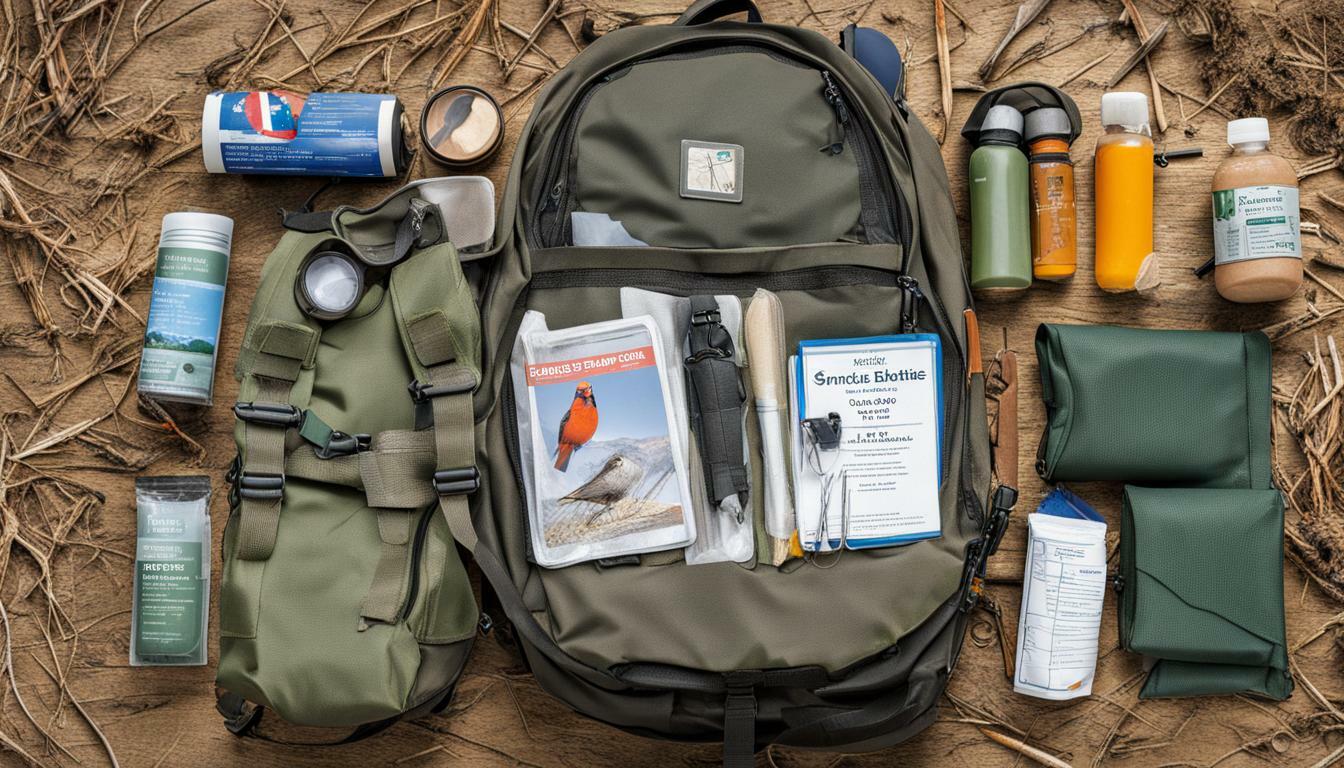As birdwatchers and nature observers, we love to immerse ourselves in the serenity of the great outdoors. However, it’s important to remember that being out in nature also comes with its fair share of risks. Accidents can happen, and that’s why it’s crucial to have the proper safety measures in place. One of the most important safety measures is having a first aid kit specifically tailored to the needs of birdwatchers and nature observers.
These kits should contain specific items that are essential for treating injuries and illnesses that might occur while out in the field. From insect bites to scrapes and cuts, a well-stocked first aid kit can make all the difference in responding swiftly and effectively to unexpected incidents.
Key Takeaways:
- Having a first aid kit for birdwatching and nature observation safety is essential
- These kits should be tailored to the specific needs of birdwatchers and nature observers
- First aid kits should be well-stocked with essential items for treating injuries and illnesses that can occur while out in nature
Birdwatching Safety Gear: Essential Birding First Aid Supplies
If you’re a birdwatcher, you know that observing birds in their natural habitats can be an exciting and rewarding experience. However, it’s important to be aware of potential hazards and take necessary precautions to ensure your safety. One way to do this is by carrying appropriate birdwatching safety gear and birding first aid supplies. In this section, we’ll explore some of the key items you should consider adding to your birdwatching safety kit.
Insect Repellent
One of the most common hazards birdwatchers face is insect bites and stings. Insects such as mosquitoes, ticks, and bees can carry diseases or cause allergic reactions. To protect yourself, make sure to pack insect repellent in your birdwatching safety kit. Look for a repellent that contains at least 20% DEET, as this is the most effective ingredient for repelling insects.
Protective Clothing
Wearing protective clothing is another important measure to prevent insect bites, sunburn, and scratches. Long-sleeved shirts and pants made of lightweight, breathable fabric can help protect your skin from the sun and bugs. Additionally, consider wearing a hat with a wide brim to shield your face and neck from the sun, and sturdy, closed-toe shoes to protect your feet from rocks and other obstacles.
Sun Protection
Spending hours outdoors exposes you to harmful UV radiation, which can cause skin damage or even skin cancer. Protect yourself from the sun’s harmful rays by wearing a high-SPF sunscreen and reapplying it every few hours. Also, carry a pair of sunglasses to protect your eyes from glare and harmful UV rays.
Birdwatching First Aid Supplies
Accidents can happen even with the best preparation. That’s why it’s crucial to carry a first aid kit designed for birdwatchers. Items that should be included in such a kit may include bandages, antiseptic wipes, tweezers, and pain relievers. By having the right first aid supplies on hand, you can quickly address minor injuries and prevent them from becoming more serious.

By taking these important steps to protect yourself and carrying appropriate birding first aid supplies, you can enjoy your birdwatching experience with peace of mind and minimal risks. In the next section, we’ll explore the essential nature observation safety equipment every birdwatcher should have on hand for emergency situations.
Nature Observation Safety Equipment
Birdwatching and nature observation are exciting outdoor activities that require adequate preparation to ensure safety. Whether you are a beginner or a seasoned birdwatcher, having the right safety equipment is crucial for emergency situations.
Here is a list of essential equipment that every birdwatcher should carry with them for proper birdwatching emergency preparedness:
| Equipment | Description |
|---|---|
| First Aid Kit | A well-equipped first aid kit specifically designed for birdwatching purposes should include items such as bandages, antiseptic wipes, insect bite relief, and tweezers. It should also have any prescribed medication for allergies, asthma, or other medical conditions. |
| Communication Devices | Carry a mobile phone, two-way radio, or personal locator beacon (PLB) for emergency communication in areas with low or no signal. |
| Navigation Tools | A compass, map, and GPS device can aid navigation, especially in unfamiliar locations. |
| Insect Repellent | Some birdwatching locations can be infested with ticks, mosquitoes, and other insects that can spread disease. Carry insect repellent containing DEET to protect against insect bites |
| Sun Protection | Protect yourself from harmful UV rays by wearing a hat, sunglasses, and sunscreen with a high sun protection factor (SPF). |
| Protective Clothing | Wear light, breathable clothing that covers your arms and legs to reduce exposure to insects, thorny plants, and other outdoor hazards. |
By having these essential safety equipment for nature observation, birdwatchers can be ready to handle unforeseen emergencies while enjoying their birdwatching activity. It is recommended to pack these items in a waterproof bag or container to keep them dry and secure.
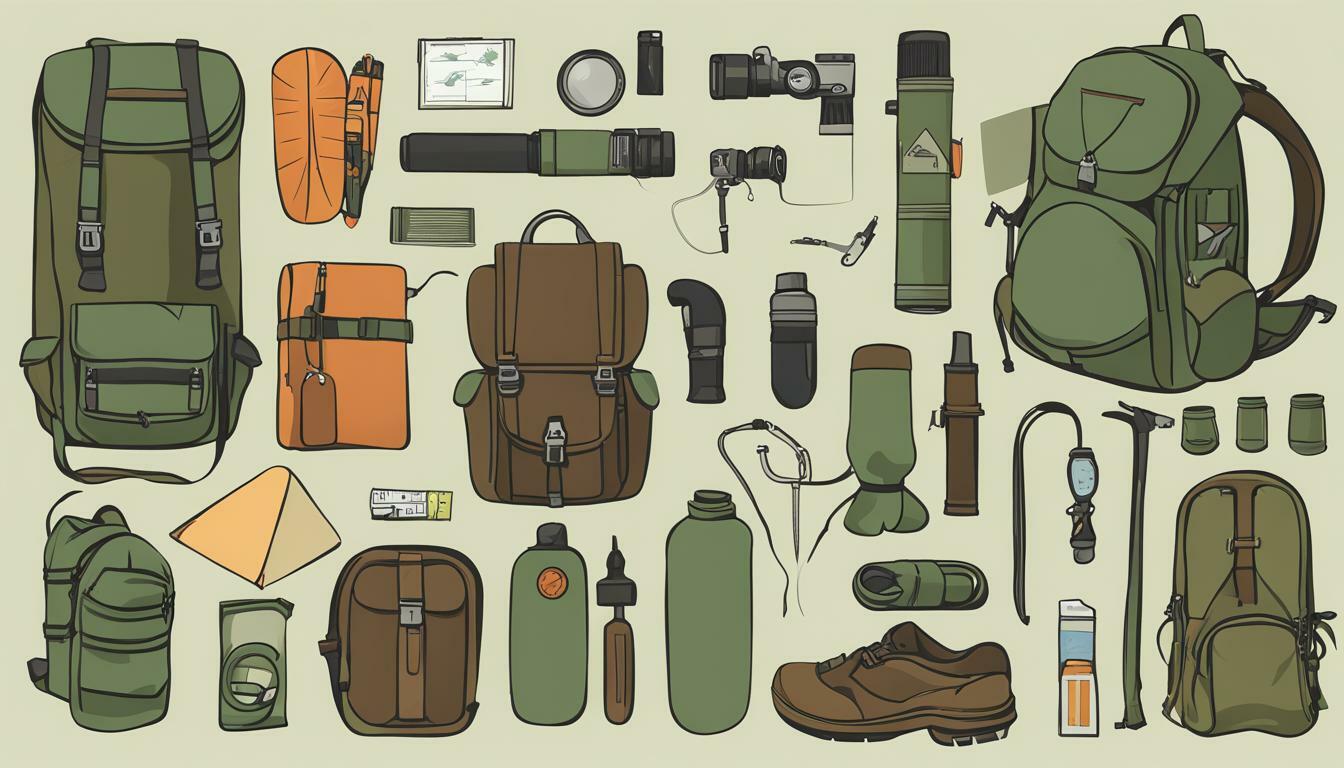
It is important to note that while having the right equipment can prevent accidents and injuries during birdwatching activities, it is not a substitute for proper training and knowledge of first aid techniques. Be sure to stay up to date with essential first aid techniques and procedures to effectively respond to different emergency situations.
Wilderness Safety Kits for Birdwatching
When it comes to birdwatching, exploring remote and secluded locations is often part of the adventure. However, it’s important to be prepared for potential hazards and emergencies that may arise in these wilderness areas. Having a wilderness safety kit specifically designed for birdwatchers is therefore essential, providing peace of mind and ensuring that necessary first aid gear is always at hand.
So, what should be included in a wilderness safety kit for birdwatching? Here are some essential items to consider:
| Item | Purpose |
|---|---|
| First Aid Supplies (e.g. bandages, antiseptic wipes, pain relief medication) | To treat minor cuts, scrapes, and injuries while in the wilderness. |
| Emergency Blanket | To keep warm and prevent hypothermia in case of an emergency. |
| Fire Starter | To aid in keeping warm, cooking, and providing light in case of an emergency. |
| Survival Whistle | To alert others in case of an emergency. |
| Multi-Tool | To provide a range of tools such as scissors, pliers, and knives. |
| Navigation Tools (e.g. map, compass, GPS) | To help navigate in unfamiliar wilderness areas. |
| Water Filtration System | To ensure access to clean drinking water in case of an emergency. |
In addition to these essential items, it’s recommended to include any other specific gear that may be necessary depending on the location and anticipated weather conditions. For example, if camping overnight, a tent, sleeping bag, and cooking supplies may be required.
Remember, wilderness safety kits for birdwatching should be regularly checked and restocked to ensure that all items are in good condition and up-to-date. By being prepared with the right first aid gear and wilderness survival tools, birdwatchers can enjoy their outdoor hobby while minimizing risks and being ready to respond to any emergency situation that may arise.
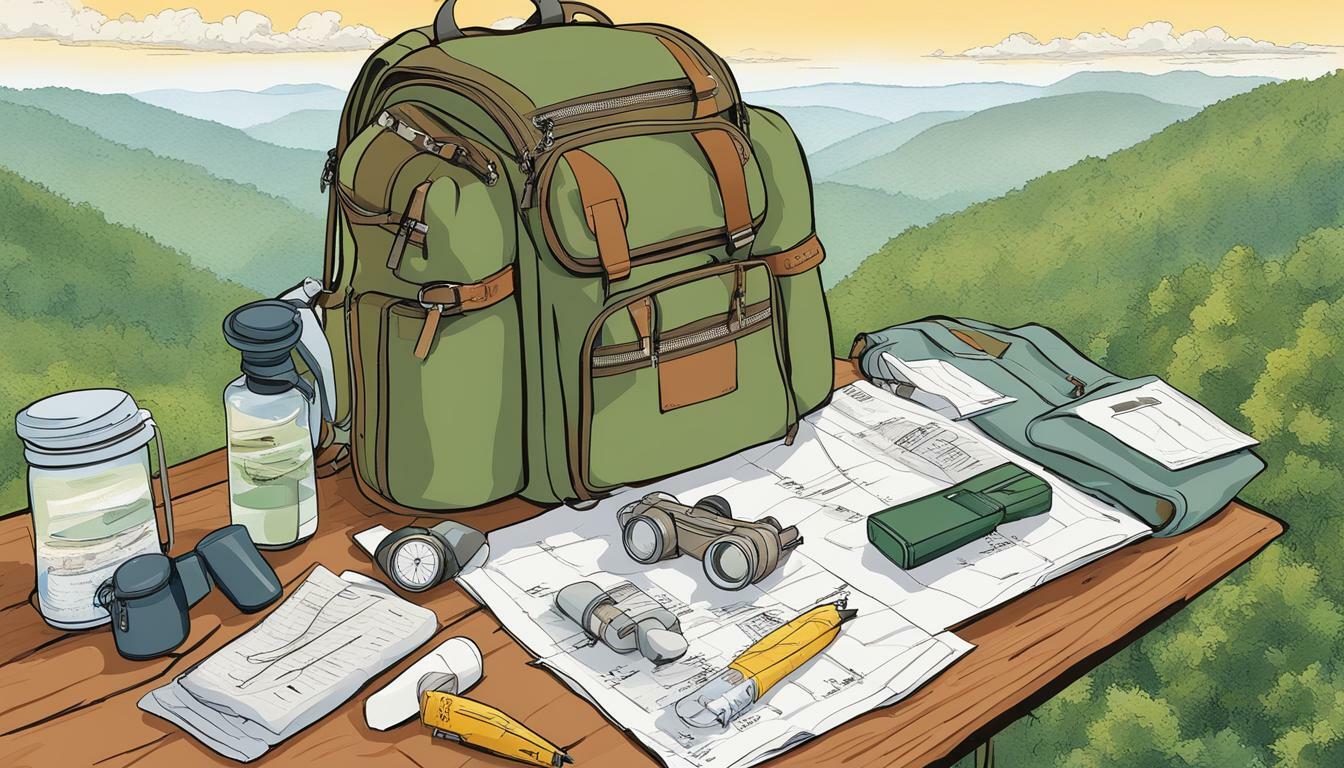
Birding Safety Essentials
When it comes to outdoor activities like birdwatching, safety should always be a top priority. Having the right outdoor safety supplies can help ensure an enjoyable and incident-free experience. Here are some birding safety essentials to consider:
- Insect repellent: Protect yourself against insect bites with an effective insect repellent. Look for products with DEET, picaridin, or IR3535 for the best protection.
- Sunscreen: Spending hours outdoors can result in harmful sun exposure. Apply a broad-spectrum sunscreen with an SPF of at least 30 before heading out.
- Sunglasses: Protect your eyes from harmful UV rays and glare with a good pair of sunglasses.
- Navigation tools: Always carry a map and compass, or a GPS device, and have a clear understanding of the area before venturing out.
- Water: Dehydration can occur quickly when engaging in outdoor activities. Bring plenty of water and drink regularly to stay hydrated.
- Snacks: High-energy snacks can help keep you going during long birdwatching sessions.
- Whistle: In case of an emergency, a whistle can be an effective way to signal for help.
- First aid kit: As discussed in previous sections, having a well-stocked first aid kit can help address injuries and accidents that may occur while birdwatching.
By ensuring you have these birding safety essentials with you, you can help minimize risks and increase your level of preparedness while exploring the great outdoors.
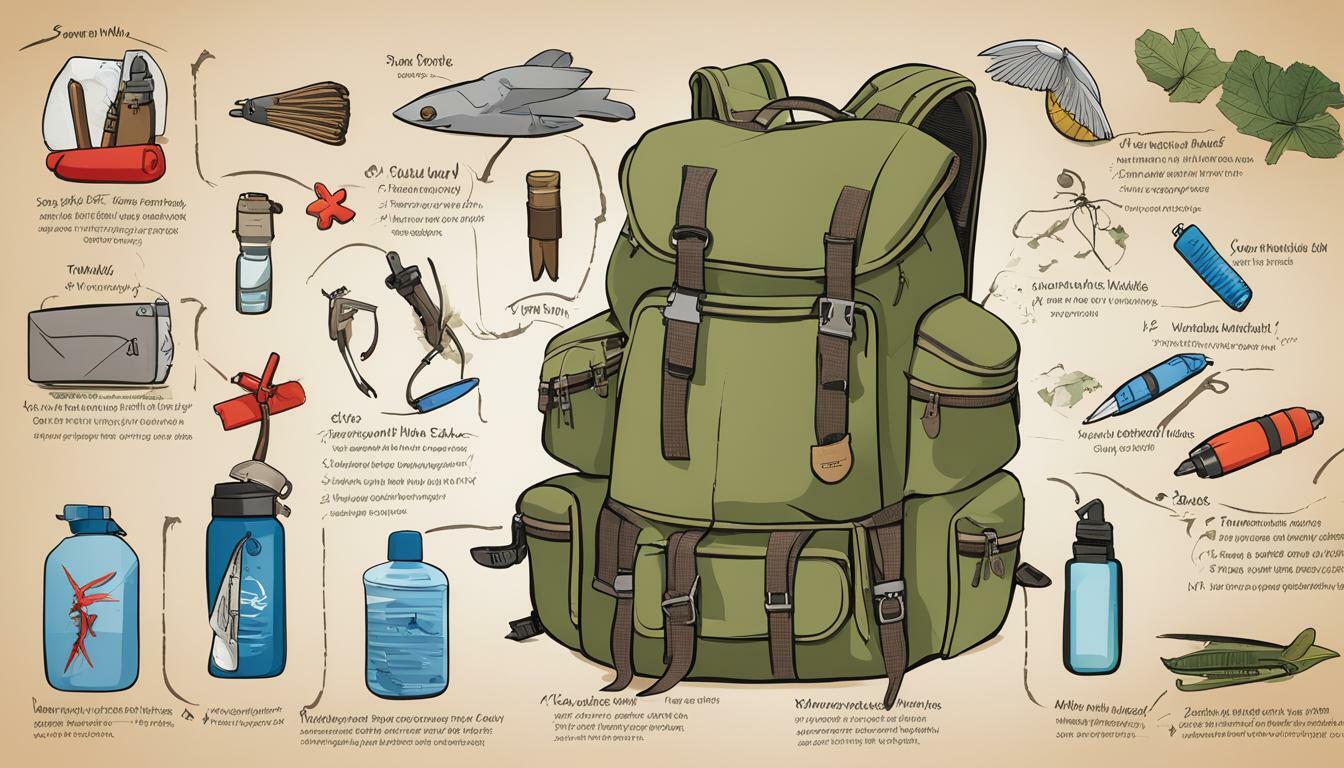
Tips for Proper First Aid Kit Preparation
As a birdwatcher, having a well-stocked first aid kit is essential for staying safe in the great outdoors. Here are some tips on how to properly prepare and organize your first aid kit:
1. Consider Your Needs
Before assembling your first aid kit, take into account any medical conditions or allergies you may have. This will ensure that you include any necessary medication or supplies specific to your needs.
2. Select the Right Container
Choose a sturdy and waterproof container that is easily accessible and can be carried comfortably on your birdwatching trips. A backpack or waist pack with multiple compartments is a good option for organizing your supplies.
3. Know What to Include
Your first aid kit should include a range of items to address different types of injuries and emergencies. Some essential items include:
| Item | Purpose |
|---|---|
| Bandages and gauze | To cover and protect cuts and wounds |
| Tweezers | To remove splinters or ticks |
| Antiseptic wipes | To clean wounds and prevent infection |
| Pain relievers | To alleviate headaches, muscle pain, etc. |
| Emergency blanket | To keep warm in case of hypothermia |
| Whistle | To signal for help in an emergency |
| Mobile phone with emergency numbers programmed | To call for assistance if needed |
4. Regularly Check and Restock Your Kit
It’s important to regularly check your first aid kit to ensure that all items are still usable and in good condition. Replace expired or damaged items and restock any supplies that have been used.
By following these tips and customizing your first aid kit to your individual needs, you can be prepared for any potential injuries or emergencies that may occur during your birdwatching adventures.
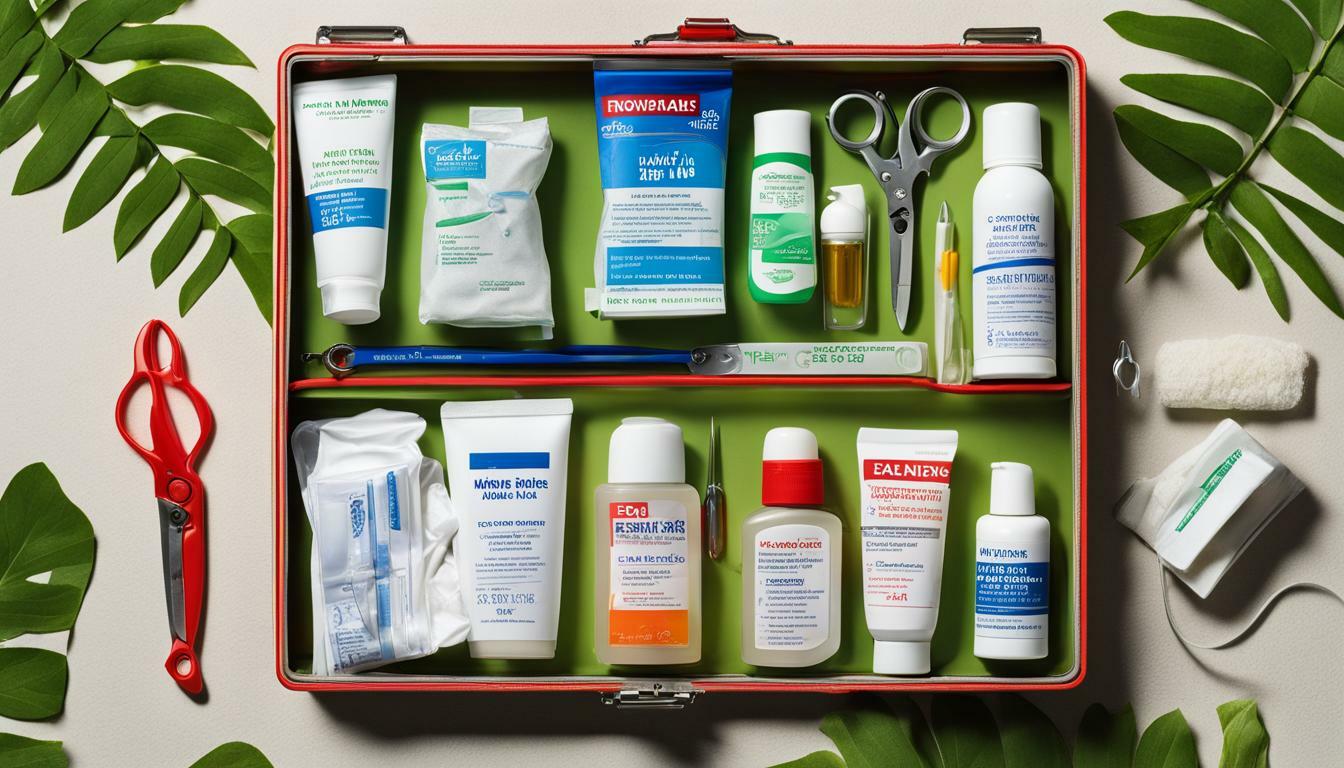
Essential First Aid Techniques for Birdwatchers
Accidents can happen anywhere, even when birdwatching. Being prepared with basic first aid knowledge can make a significant difference in an emergency situation. Here are some essential first aid techniques that every birdwatcher should be familiar with:
Bleeding
If a person has been injured and is bleeding heavily, the first step is to apply direct pressure to the wound using a clean cloth or bandage. Elevate the injured area above the heart to help slow down the bleeding. If bleeding persists, seek medical attention immediately.
Burns
In case of burns caused by hot liquids or fire, immediately run cool water over the affected area for at least 10 minutes to alleviate the pain and prevent blistering. If the burn is severe, cover the area with a clean, dry cloth and seek medical attention.
Fractures and Sprains
If a person has suffered a fracture or sprain, try to immobilize the affected area using a splint or bandage. Apply ice to the injured area to reduce swelling and pain. Seek medical attention as soon as possible.
Allergic Reaction
If a person experiences an allergic reaction to a bee or insect sting, administer an antihistamine immediately, and try to keep the person calm and immobile. If the reaction is severe, seek medical attention immediately.
Choking
If a person is choking, try performing the Heimlich maneuver by standing behind the person and pressing your fist into their abdomen, just above the navel. Alternatively, you can perform back blows by standing behind the person and hitting them firmly between the shoulder blades. Seek medical attention immediately after dislodging the object.
It’s essential to remember that these first aid techniques are not substitutes for professional medical attention. In case of a severe injury or medical emergency, seek help immediately by calling the emergency services in the UK at 999 or 112.
Being well-prepared with essential first aid techniques can significantly increase a birdwatcher’s safety and improve their overall experience. Remember to regularly check and update your first aid kit and familiarize yourself with how to use the supplies inside. By doing so, you can stay safe and make the most out of your birdwatching adventures.

Reporting Wildlife Emergencies
If you encounter a wildlife emergency or incident during your birdwatching activities, it is essential to report it as soon as possible. Reporting such incidents helps authorities gain a better understanding of the area’s ecological status, enabling them to take measures to preserve and protect the habitats and wildlife. Additionally, reporting wildlife emergencies helps to prevent future accidents and injuries.
When reporting wildlife emergencies, it is critical to provide as much information as possible. This includes the location of the incident, the date and time it occurred, and any relevant details about the wildlife involved. If possible, take photographs of the area and the wildlife involved, as this can help authorities better understand the situation.
Ensure that you report the incident to the appropriate authority. This may be a local wildlife rescue organization, government agency, or park ranger. Look up the relevant contact information and make sure you have it with you before embarking on your birdwatching excursion to ensure that you can report any incidents promptly.
Remember, reporting wildlife emergencies is essential not only for the conservation of wildlife but also for your safety as a birdwatcher. By reporting incidents, you can help ensure that proper safety measures are put in place to prevent future accidents and injuries.
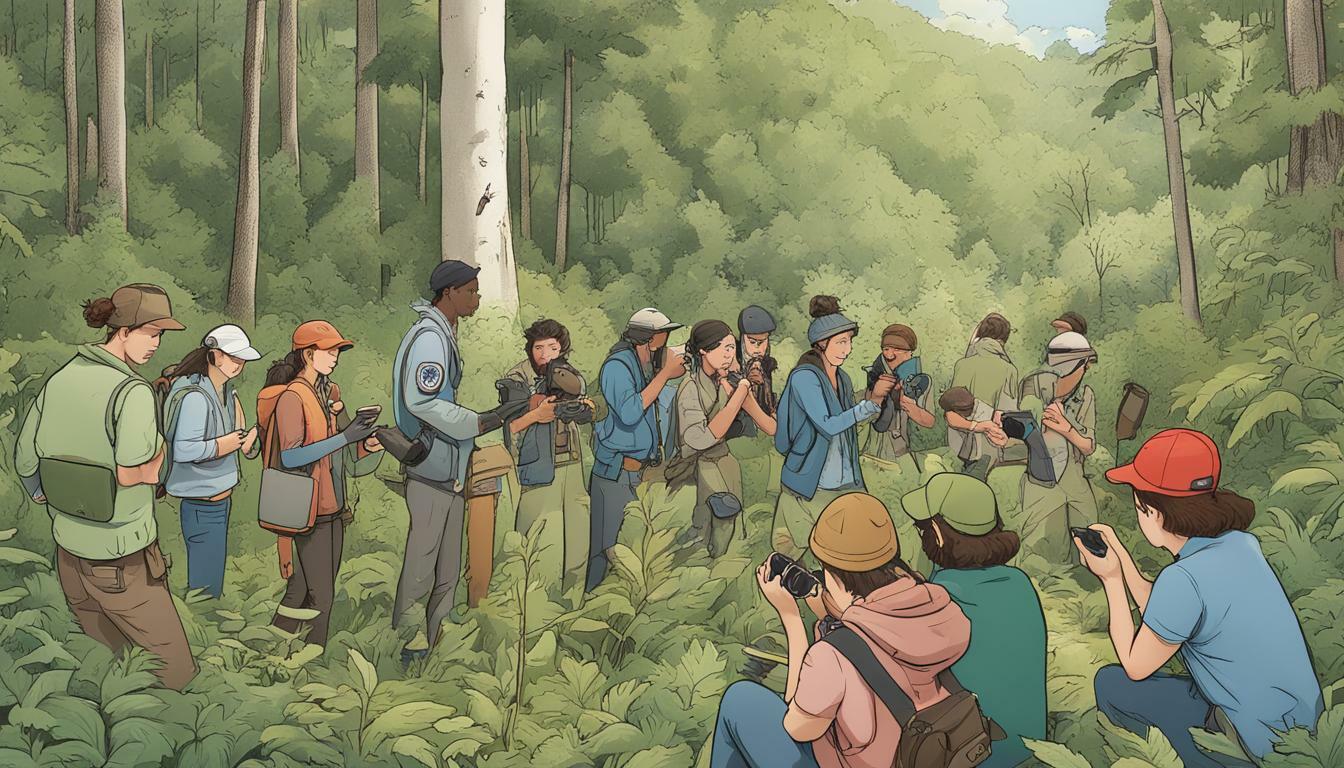
Birdwatching Safety Tips
Birdwatching is an exciting and rewarding activity that allows us to connect with nature and observe the beauty of birds in their natural habitats. However, it is important to keep in mind the potential risks and hazards that come with outdoor activities. Here are some essential birdwatching safety tips to ensure a safe and enjoyable experience:
- Research the location: Before heading out, research the birdwatching location to understand the terrain, weather conditions, and potential hazards such as poisonous plants or dangerous animals.
- Dress appropriately: Wear comfortable and protective clothing that covers the body. Consider wearing a hat, sunglasses, and sunscreen to protect against the sun. Additionally, wear appropriate footwear for the terrain.
- Stay hydrated: Bring plenty of water and stay hydrated throughout the trip. Avoid consuming untreated water from streams or lakes.
- Respect wildlife: Observe birds from a safe distance and avoid disturbing their natural habitats. Do not approach birds too closely or touch their nests or eggs.
- Be prepared: Carry a first aid kit, a map or GPS device, and a communication device such as a mobile phone or whistle. Additionally, inform someone of your plans and expected return time.
- Stay on designated paths: Stick to designated paths and avoid walking on fragile or unstable terrain to avoid accidents or damage to the environment.
- Be aware of weather conditions: Check weather forecasts before heading out and be aware of potential weather changes. Seek shelter in case of lightning storms or other dangerous weather conditions.
By following these birdwatching safety tips and guidelines, you can ensure a safe and responsible nature observation experience. Remember to always prioritize safety and respect for wildlife when engaging in outdoor activities.
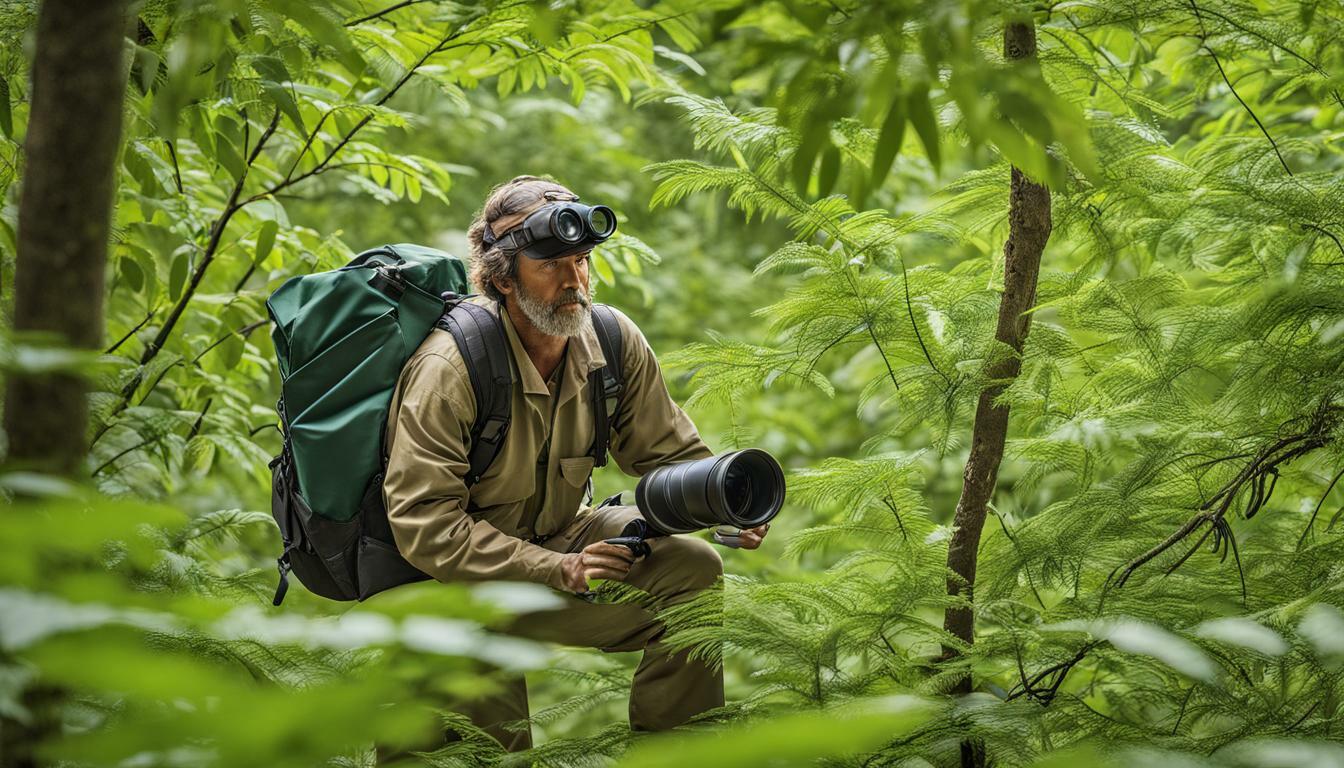
Choosing the Right First Aid Kit for Birdwatching
When it comes to birdwatching safety equipment, a well-stocked first aid kit is essential to have on hand. But with so many different types of first aid kits available, it can be overwhelming to choose the right one for your needs.
Here are some tips to help you select the perfect first aid kit for birdwatching:
| Consider the Duration of Your Trips | The length of your birdwatching trips will determine the amount and type of supplies you need. For shorter outings, a basic kit with essential items such as bandages, antiseptic wipes, and insect repellent may suffice. For longer trips, a more comprehensive kit with additional items such as medications, emergency blankets, and tweezers may be necessary. |
|---|---|
| Assess the Accessibility of Your Location | The availability of medical assistance in your location should also be taken into account. If you’re birdwatching in remote or secluded areas, you’ll need a kit that can handle potentially serious injuries or illnesses. If you’ll be near medical facilities, a smaller kit with the basics may be all that’s necessary. |
| Consider Your Personal Medical Needs | Your individual medical requirements should also be considered when selecting a first aid kit. If you have allergies or require regular medications, make sure your kit includes the necessary items. It’s also important to check the expiration dates of any medications in your kit and replace them as needed. |
Ultimately, the goal is to have a first aid kit that’s tailored to your specific needs and situation:
- Choose a kit that includes the essential items for your birdwatching trips.
- Consider the accessibility of your location and medical needs.
- Regularly check and restock your kit to ensure its effectiveness.
Investing in a quality first aid kit is an investment in your safety while birdwatching. Don’t let a preventable injury or illness ruin your outdoor experience. With the right kit and preparation, you can enjoy your birdwatching adventures with peace of mind.
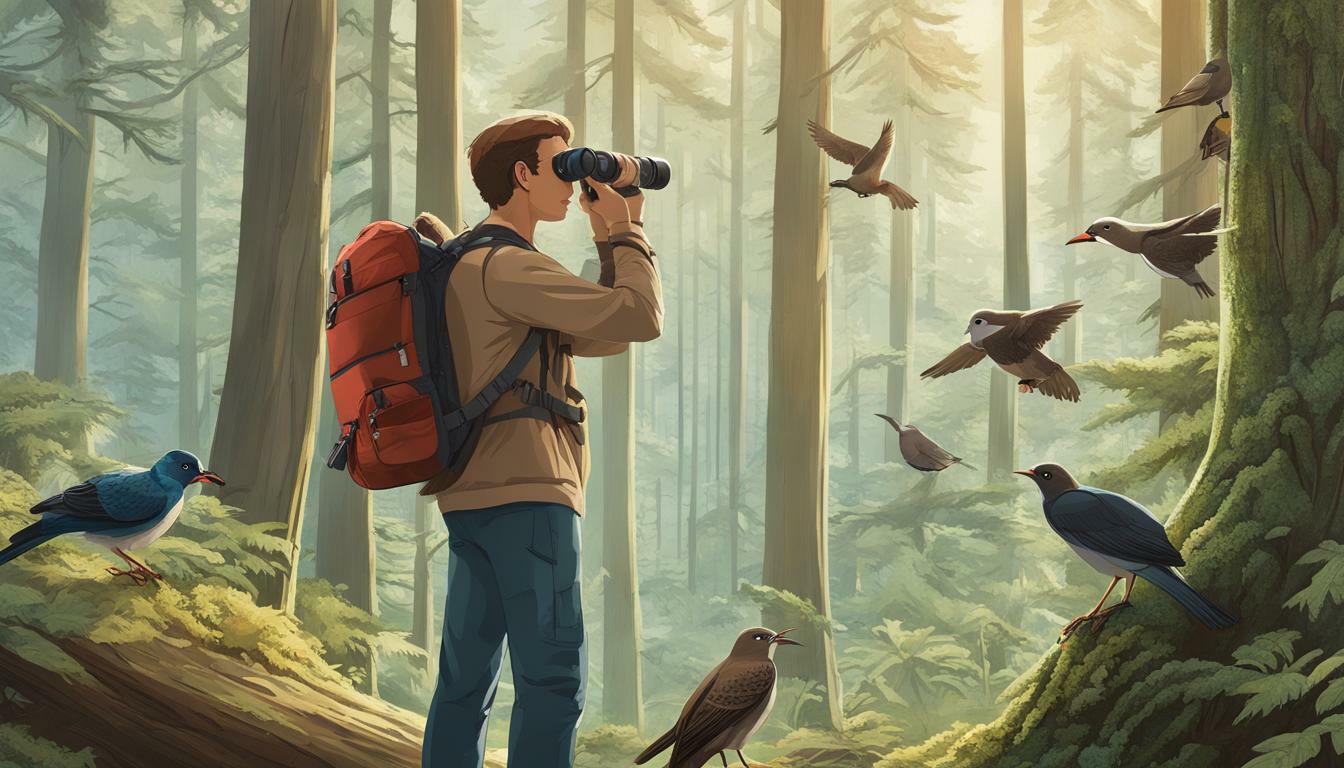
Conclusion
In summary, birdwatching and nature observation are enjoyable outdoor activities that require proper safety measures to ensure a positive experience. By equipping yourself with a first aid kit specifically designed for birdwatching and nature observation, you can be prepared for potential hazards and emergencies in the field.
It is important to select the right kit for your needs, considering factors such as the duration of your trip, the accessibility of the location, and your individual medical requirements. Additionally, being familiar with essential first aid techniques and procedures can make all the difference in responding effectively to different situations.
Remember to follow safety guidelines when observing wildlife and to report any incidents or emergencies encountered during your birdwatching activities. By staying informed and prepared, you can enjoy a responsible and safe birdwatching experience.
